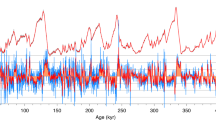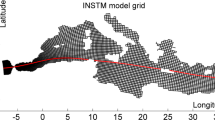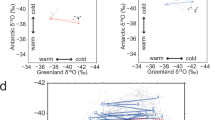Abstract
Different reconstructions of glacial sea-surface temperatures (SST) are used to force a hybrid coupled atmosphere–ocean model. The resulting glacial states differ in global salinity and temperature distributions, and consequently in the strength of the thermohaline circulation. Stability analysis of the Atlantic Ocean circulation, by means of freshwater-flux hysteresis maps, reveals mono-stability for each glacial background state, which appears to be a robust feature of the glacial ocean. We show that this behaviour is directly linked to the hydrological cycle. A monotonic relation between the freshwater input necessary for reaching the off-mode and the hydrological budget in the Atlantic catchment area, accounts for the sensitivity of the ocean’s circulation. The most sensitive part of the hydrological balance appears to be in the tropical and subtropical regions suggesting that the ‘Achilles heel’ of the global conveyor belt circulation is not restricted to the northern North Atlantic where convection occurs.










Similar content being viewed by others
References
Adkins JF, McIntyre K, Schrag DP (2002) The salinity, temperature and δ18O content of the glacial deep ocean. Science 298: 1769–1773
Bickert T, Mackensen A (2003) Last Glacial to Holocene Changes in South Atlantic deep water circulation. In: The South Atlantic in the Quaternary Reconstruction of material budget and current systems. Wefer G, Mulitza S, Rathmeyer V, . Springer, Berlin Heidelberg, pp 599–620
Boyle EA (1992) Cadmium and δ13C paleochemical ocean distribution during the stage 2 glacial maximum. Ann Rev Earth Planet Sci 20: 245–287
Boyle EA, Keigwin LD (1987) North Atlantic thermohaline circulation during the past 20,000 years linked to high-latitude surface temperature. Nature 330: 35–40
Broecker WS, Hemming S (2001) Climate swings come into focus. Science 294: 2308–2309
Bryan F (1986) High-latitude salinity effects and interhemispheric thermohaline circulations. Nature 323: 301–304
Calov R, Ganopolski A, Petoukhov V, Claussen M, Greve R (2002) Large-scale instabilities of the Laurentide ice sheet simulated in a fully coupled climate-system model. Geophys Res Let 29: 2216, doi:10.1029/2002GL016078
Chappell J (2002) Sea level changes forced ice breakouts in the Last Glacial cycle: new results from coral terraces. Quat Sci Rev 21: 1229–1240
Clark PU, Pisias NG, Stocker TF, Weaver AJ (2002) The role of the thermohaline circulation in abrupt climate change. Nature 415: 863–869
CLIMAP project members (1981) Seasonal reconstructions of the Earth surface at the Last Glaial Maximum. Geological Society of America Map and Chart Series, MC-36, 18 maps, Boulder, Colorado, USA
de Vernal A, Hillaire-Marcel C (2000) Sea-ice cover, sea-surface salinity and halo-/thermocline structure of the northwest North Atlantic: modern versus full glacial conditions. Quat Sci Rev 19: 65–68
Duplessy JC, Shackelton NJ, Fairbanks RG, Labeyrie L, Oppo D, Kallel N (1988) Deepwater source variations during the last climatic cycle and their impact on the global deepwater circulation. Paleoceanography 3: 343–360
Duplessy JC, Labeyrie L, Juillet-Leclerc A, Maitre F, Duprat J, Sarnthein M (1991) Surface salinity reconstruction of the North Atlantic Ocean during the last glacial maximum. Oceanologica Acta 14: 311–324
Fanning AF, Weaver AJ (1997) Temporal-geographical meltwater influences on the North Atlantic conveyor: implications for the Younger Dryas. Paleoceanography 12: 307–320
Farrera I, Harrison SP, Prentice IC, Ramstein G, Guiot J, Bartlein PJ, Bonnefille R, Bush M, Cramer W, von Grafenstein U, Holmgren K, Hooghiemstra H, Hope G, Jolly D, Lauritzen SE, Ono Y, Pinot S, Stute M, Yu G (1999) Tropical climates at the Last Glacial Maximum: a new synthesis of terrestrial paleoclimate data. I. Vegetation, lake-levels and geochemistry. Clim Dyn 15: 823–856
Ganopolski A, Rahmstorf S (2001) Simulation of rapid glacial climate change in a coupled climate model. Nature 409: 153–158
Gordon AL (1986) Interocean exchange of thermocline water. J Geophys Res 91: 5037–5046
Hewitt CD, Broccoli AJ, Mitchell JFB, Stouffer RJ (2001) A coupled model study of the last glacial maximum: was part of the North Atlantic relatively warm? Geophys Res Lett 28: 1571–1574
Kitoh A, Murakami FS, Koide H (2001) A simulation of the Last Glacial Maximum with a coupled atmosphere-ocean GCM. Geophys Res Lett 28: 2221–2224
Knorr G, Lohmann G (2003) Southern Ocean origin for resumption of Atlantic thermohaline circulation during deglaciation. Nature 424: 532–536
Latif M, Roeckner E, Mikolajewicz, Voss R (2000) Tropical stabilization of the thermohaline circulation in a Greenhouse warming simulation. J Clim 13: 1809–1813
Lautenschlager M, Mikolajewicz U, Maier-Reimer E, Heinze C (1992) Application of ocean models for the interpretation of the atmospheric general circulation model experiments on the climate of the Last Glacial Maximum. Paleoceanography 7: 769–782
Leonard BP (1979) A stable and accurate convective modelling procedure based on quadratic upstraem interpolation. Comput Meth Appl Mech Eng 19: 59–98
Lohmann G (2003) Atmospheric and oceanic freshwater transport during weak Atlantic overturning circulation. Tellus 55A: 438–449
Lohmann G, Lorenz S (2000) On the hydrological cycle under paleoclimatic conditions as derived from AGCM simulations. J Geophys Res 105: 17,417–17,436
Lohmann G, Gerdes R, Chen D (1996a) Sensitivity of the thermohaline circulation in coupled oceanic GCM-atmospheric EBM experiments. Clim Dyn 12: 403–416
Lohmann G, Gerdes R, Chen D (1996b) Stability of the thermohaline circulation in a simple coupled model. Tellus 48A: 465–476
Maier-Reimer E, Mikolajewicz U (1989) Experiments with an OGCM on the cause of the Younger Dryas. Tech. Rep. 39, Max-Planck-Inst for Meteorol, Hamburg, pp 13
Maier-Reimer E, Mikolajewicz U, Hasselmann K (1993) Mean circulation of the Hamburg LSG OGCM and its sensitivity to the thermohaline surface forcing. J Phys Oceanogr 23: 731–757
Manabe S, Stouffer RJ (1995) Simulation of abrupt climate change induced by freshwater input to the North Atlantic Ocean. Nature 378: 165–167
Marchitto TM, Oppo DW, Curry WB (2002) Paired benthic foraminiferal Cd/Ca and Zn/Ca evidence for a greatly increased presence of Southern Ocean Water in the glacial North Atlantic. Paleoceanography 17: 1038, doi:10.1029/2000PA000PA000598
Mikolajewicz U, Maier-Reimer E (1994) Mixed boundary conditions in ocean general circulation models and their influence on the stability of the model’s conveyor belt. J Geophys Res 99: 22,633–22,644
Mix AC, Bard E, Schneider R (2001) Environmental processes of the Ice Age: land, ocean, glaciers (EPILOG). Quat Sci Rev 20: 627–657
Paul A, Schäfer-Neth C (2003) Modeling the water masses of the Atlantic Ocean at the Last Glacial Maximum. Paleoceanography 18(3): 1058, doi:10.1029/2002PA000783
Peltier WR (1994) Ice age paleotopography. Science 265: 195–201
Prange M, Lohmann G, Gerdes R (1997) Sensitivity of the thermohaline circulation for different climates – investigations with a simple atmosphere-ocean model. Palaeoclimates 2: 71–99
Prange M, Romanova V, Lohmann G (2002) The glacial thermohaline circulation: stable or unstable? Geophys Res Lett 29: 2028, doi:10.1029/2002GL015337
Prange M, Lohmann G, Romanova V, Butzin M (2004) Modelling tempo-spatial signatures of Heinrich Events: influence of the climatic background state. Quat Sci Rev 23:521–527
Prange M, Lohmann G, Paul A (2003) Influence of vertical mixing on the thermohaline hysteresis: analyses of an OGCM. J Phys Oceanogr 33: 1707–1721
Rahmstorf S (1995) Bifurcations of the Atlantic thermohaline circulation in response to changes in the hydrological cycle. Nature 378: 145–149
Rahmstorf S (1996) On the freshwater forcing and transport of the Atlantic thermohaline circulation. Clim Dyn 12: 799–811
Rahmstorf S, Willebrand J (1995) The role of temperature feedback in stabilizing the thermohaline circulation. J Phys Oceanogr 25: 787–805
Rind D, deMenocal P, Russell G, Sheth S, Collins D, Schmidt GA, Teller J (2001) Effects of glacial meltwater in the GISS coupled atmosphere-ocean model: Part I: North Atlantic Deep Water response. J Geophys Res 106: 27,335–27,354
Roeckner E, Arpe K, Bengtsson L, Brinkop S, Dümenil L, Esch M, Kirk E, Lunkeit F, Ponater M, Rockel B, Sausen R, Schlese U, Schubert S, Windelband M (1992) Simulation of the present-day climate with ECHAM model: impact of model physics and resolution, S. 28, Hamburg, Germany, pp 171
Rühlemann C, Mulitza S, Lohmann G, Paul A, Prange M, Wefer G (2004) Intermediate-depth warming in the tropical Atlantic related to weakened thermohaline circulation: combining paleoclimate and modeling data for the last deglaciation. Paleoceanography 19. Doi:1029/2003PA0000948
Rutberg RL, Hemming SR, Goldstein SL (2000) Reduced North Atlantic Deep Water flux to the glacial Southern Ocean inferred from neodymium isotope ratios. Nature 405: 935–938
Saenko O, Gregory JM, Weaver AJ, Eby M (2002) Distinguishing the influence of heat, freshwater, and momentum fluxes on ocean circulation and climate. Clim Dyn 15: 3686–3697
Sarnthein M, Gersonde R, Niebler S, Pflaumann U, Spielhagen R, Thiede J, Wefer G, Weinelt M (2003) Overview of Glacial Atlantic Ocean Mapping (GLAMAP 2000). Paleoceanography 18: 1030, doi:10.1029/2002PA000769
Schäfer-Neth C, Paul A (2001) Circulation of the glacial Atlantic: a synthesis of global and regional modeling. In: The Northern North Atlantic: A Changing Environment. Schäfer IP, Ritzrau W, Schlüter M, Thiede J, Springer, Berlin, pp 446–462
Schiller A, Mikolajewicz U, Voss R (1997) The stability of the North Atlantic thermohaline circulation in a coupled ocean-atmosphere general circulation model. Clim Dyn 13: 325–347
Schmittner A, Clement AC (2002) Sensitivity of the thermohaline circulation to tropical and high latitude freshwater forcing during the last glacial-interglacial cycle. Paleoceanography 17: 10.1029/2000PA000591
Schmittner A, Yoshimori M, Weaver AJ (2002) Instability of glacial climate in a model of ocean-atmosphere-cryosphere system. Science 295: 1489–1493
Shin S, Liu Z, Otto-Bliesner BL, Brady EC, Kutzbach JE, Harrison SP (2003) A simulation of the Last Glacial Maximum climate using the NCAR-CCSM. Clim Dyn 20: 127–151
Stocker TF, Wright DG (1991) Rapid transitions of the ocean’s deep circulation induced by changes in surface water fluxes. Nature 351: 729–732
Stommel H (1961) Thermohaline convection with two stable regimes of flow. Tellus 13: 224–230
Volbers ANA, Henrich R (2002) Present water mass calcium carbonate corrosiveness in the eastern South Atlantic inferred from ultrastructural breakdown of Globigerina bulloides in surface sediments. Marine Geology 186:471–486
Weaver AJ, Eby M, Fanning AF, Wiebe EC (1998) Simulated influence of carbon dioxide, orbital forcing and ice sheets on the climate of the Last Glacial Maximum. Nature 394: 847–853
Weinelt M, Sarnthein M, Pflaumann U, Schulz H, Jung S, Erlenkeuser H (1996) Ice-free Nordic Seas during the Last Glacial Maximum? Potential sites of deepwater formation. Palaeoclimates 1: 283–309
Winguth AME, Archer D, Maier-Reimer E, Mikolajewicz U, Duplessy JC (1999) Sensitivity of paleonutrient tracer distributions and deep-sea circulation to glacial boundary conditions. Palaeoceanography 14: 304–323
Yu EF, Francois R, Bacon MP (1996) Similar rates of modern and last glacial ocean thermohaline circulation inferred from radiochemical data. Nature 379: 689–694
Acknowledgements
We gratefully acknowledge the comments and suggestions of Andre Paul, Christian Schäfer-Neth and Klaus Grosfeld, and Andreas Manschke and Silke Schubert for technical support. We also thank the reviewers for constructive comments. The study was funded by the BMBF through DEKLIM project Climate transitions and by the Deutsche Forschungsgemeinschaft as a part of the DFG Research Centre ‘Ocean Margins’ of the University of Bremen (No. RCOMO127).
Author information
Authors and Affiliations
Corresponding author
Rights and permissions
About this article
Cite this article
Romanova, V., Prange, M. & Lohmann, G. Stability of the glacial thermohaline circulation and its dependence on the background hydrological cycle. Climate Dynamics 22, 527–538 (2004). https://doi.org/10.1007/s00382-004-0395-z
Received:
Accepted:
Published:
Issue Date:
DOI: https://doi.org/10.1007/s00382-004-0395-z




